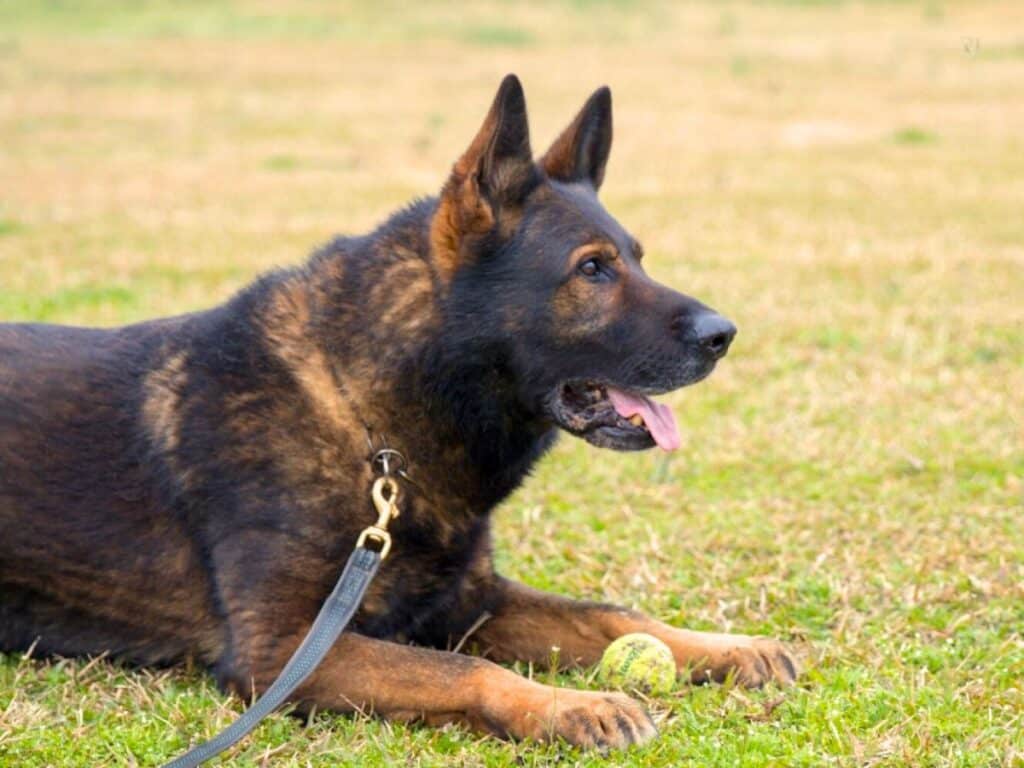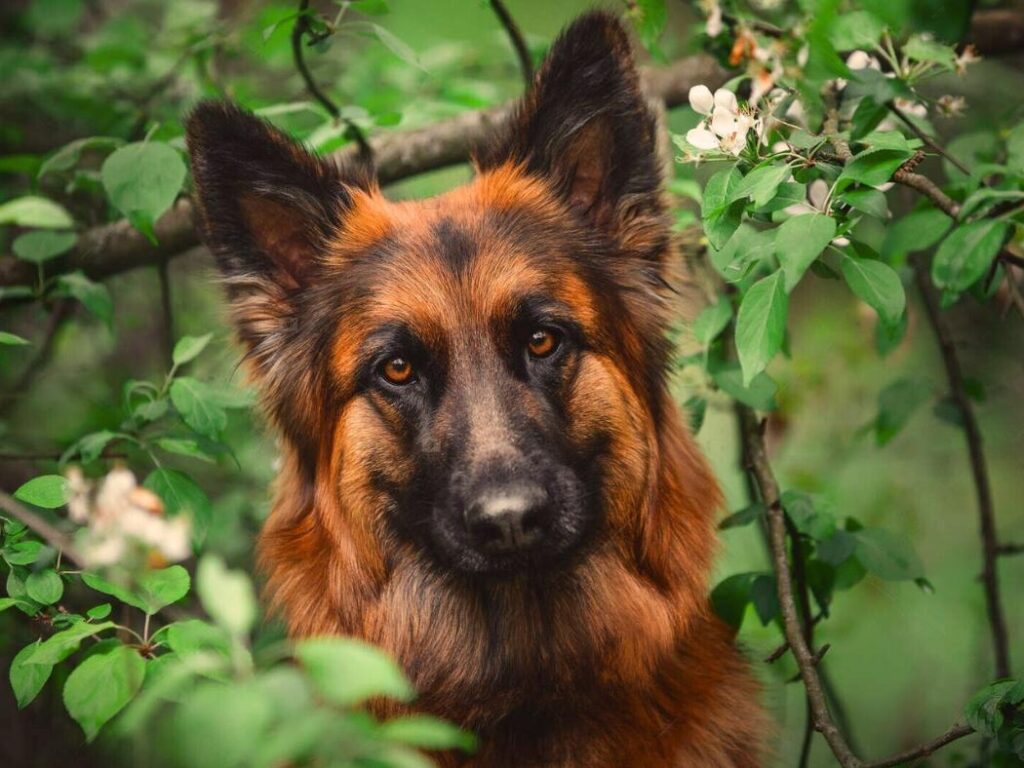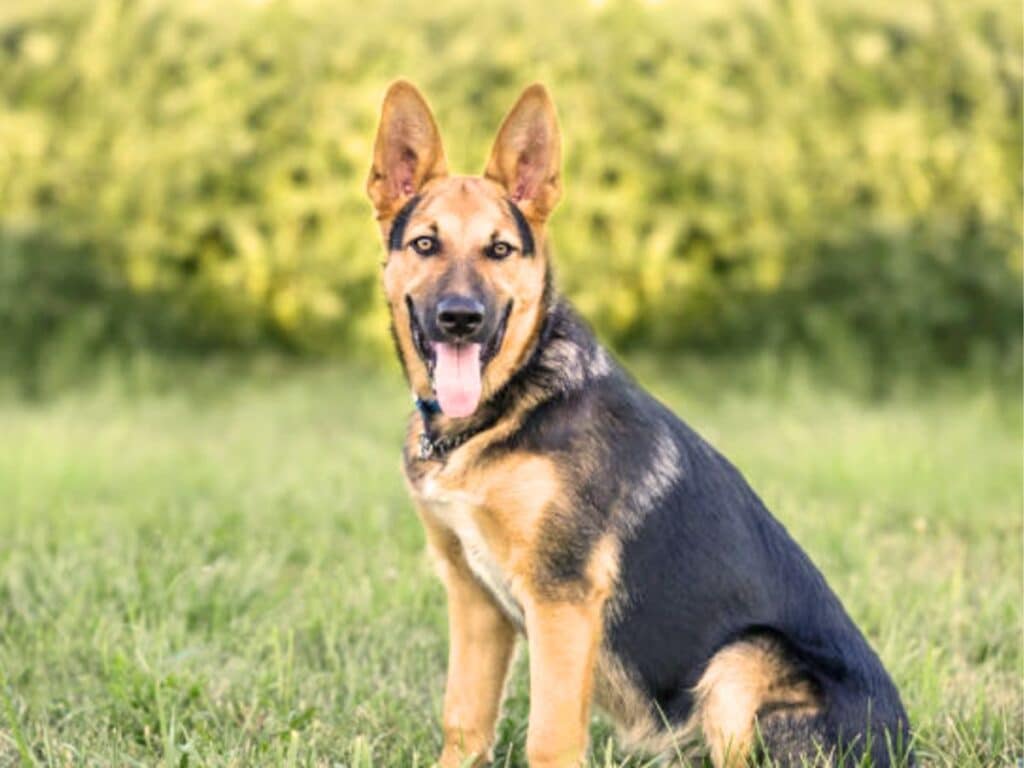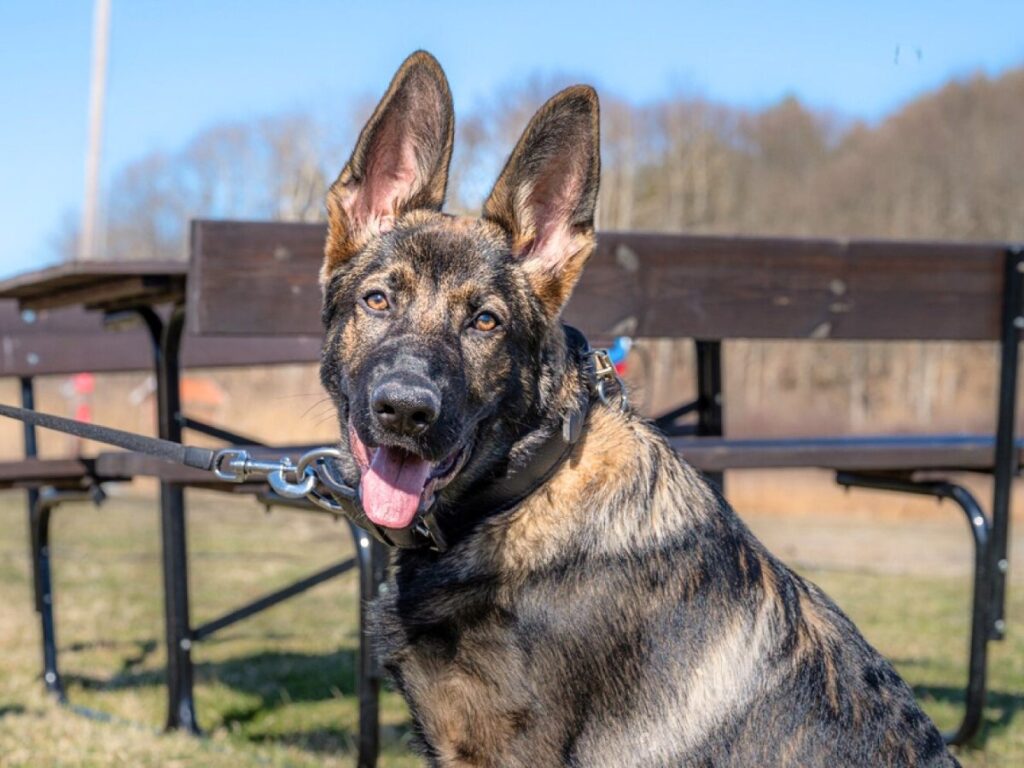Czech German Shepherds are a breed that is quickly gaining popularity among dog lovers. This distinct breed originated from the former Czechoslovakia and has become known for its strength, intelligence, and affectionate nature.
Originally bred for military and police work, Czech German Shepherds have since become popular as family pets due to their loyalty and protective instincts.
These dogs are known for having a straight back, dark eyes, and a thick coat. They are also confident, courageous, trainable, and possessive of their owners.
Czech German Shepherd Overview
Czech German Shepherds have specific breed standards that include the following physical and behavioral traits.
| Height (Male) | 24 – 26 inches |
| Height (Female) | 22 – 24 inches |
| Weight (Male) | 66 – 88 pounds |
| Weight (Female) | 49 – 71 pounds |
| Appearance | Similar to the traditional German Shepherd, with a strong, well-muscled body and erect ears. May have a more straighter back, blocky heads, deep chests, and large paws |
| Coat | Double coat with a thick undercoat and a medium-length outer coat. Common colors include black and tan. |
| Temperament | Intelligent, loyal, and trainable. Known for high energy levels and a strong work drive. Athletic, affectionate, and obedient too. |
| Drive & Work Ethic | Typically bred for strong working abilities, including tracking, protection, and obedience. High prey and play drives. |
| Trainability | Highly trainable with a desire to work and please their owners. |
| Health | Generally robust and healthy, but like typical GSDs, they can be prone to certain health issues such as hip dysplasia and elbow dysplasia. |
| Lifespan | Typically around 9 to 13 years. |
| Compatibility | Can be good family dogs with proper training and socialization. May do well in homes with active individuals or families who can provide the mental and physical stimulation they need. |
What Does a Czech German Shepherd Look Like?
The Czech German Shepherd, also known as the Czech line or working line German Shepherd, shares many physical characteristics with the traditional German Shepherd breed.
However, there can be some distinctions in appearance, especially in terms of the working traits they are selectively bred for.

Here are some common features of the Czech German Shepherd:
- Strong and well-muscled body.
- May have a more straight-backed appearance compared to the sloped back often seen in show-line German Shepherds.
- Double coat with a thick undercoat and a medium-length outer coat.
- Common colors include black and tan.
- Wedge-shaped head.
- Dark, almond-shaped eyes.
- Erect ears that stand straight up.
- Bushy tail that hangs down when at rest.
- Generally medium to large-sized dogs.
- Fluid and efficient movement.
- Alert and intelligent expression.
It’s important to note that while there are general characteristics associated with the Czech German Shepherd, individual dogs within this line can vary in appearance. The focus in breeding Czech German Shepherds is often on working ability, intelligence, and temperament rather than conforming to a specific appearance standard.
Czech German Shepherd Growth Chart
The following Czech German Shepherd Growth Chart will help you gain valuable insights into the stages of your pup’s development, allowing you to provide the optimal care and support needed for a happy, healthy companion.

Czech German Shepherd History
Czech Shepherds have a long and fascinating history as working line dogs. Originally bred as herding dogs in the Czech Republic, these intelligent and trainable animals quickly became popular for police and military work due to their exceptional abilities. (Source)

In the 1950s, breeders began crossing German Shepherds with Czech working lines to create a new bloodline that would be even more suited to this type of work.
The result was the Czech Shepherd bloodline, which quickly gained popularity among law enforcement agencies around the world.
These dogs were known for their strong work ethic and high drive, making them ideal for tasks such as search and rescue, drug detection, and protection work.
Of course, the Czech Shepherd is not the only GSD bloodline that has been used extensively as a working line dog.
DDR German Shepherds from East Germany also have a long history of being used in police and border patrol work.
These dogs were bred specifically for their working abilities, with an emphasis on traits such as loyalty, courage, and intelligence.
Today, many different types of German Shepherd bloodlines are used for various types of working line roles. Some are bred specifically for police or military work, while others may be trained as service animals or search and rescue dogs.
One thing that all of these bloodlines have in common is their exceptional trainability. German Shepherds are highly intelligent animals that respond well to positive reinforcement training methods.
RELATED: Working Line vs Show Line German Shepherd: The Real Difference
Czech German Shepherd Characteristics

Personality
The Czech GSD has a strong personality that is often described as confident, assertive, and fearless. These dogs are not afraid to take charge of situations and are known for their natural leadership qualities.
They are characterized by high energy levels, requiring regular exercise and mental stimulation.
Czech German Shepherds often retain a playful nature well into adulthood.
They are highly intelligent and have a strong desire to please their owners, making them easy to train. With proper training and socialization from an early age, these dogs can be great family pets.
Temperament
These dogs are known for their exceptional intelligence, which makes them highly adaptable to various environments and situations. They have a strong work ethic and thrive on challenges that require mental stimulation.
Their high energy levels make them ideal for active families who enjoy outdoor activities such as hiking or running.
Czech Shepherds often exhibit a natural protective instinct, making them excellent guard dogs.
Despite their tough exterior, Czech German Shepherds are also affectionate and loyal to their owners. They form strong bonds with their families and enjoy spending time with them.
However, they can be wary of strangers and may require proper socialization to prevent aggression towards unfamiliar people or animals.
RELATED: German Shepherd Pros and Cons
Intelligence and Trainability
Known for their exceptional intelligence, Czech German Shepherds are quick learners and highly trainable.
Bred for working abilities, they have a strong work drive and excel in tasks that require problem-solving skills.
Working abilities
Bred for their working abilities, Czech German Shepherds excel in various roles, including tracking, protection work, and obedience.
They possess a strong prey drive and are motivated to perform tasks.
Did you know that there are other different types of German Shepherds, such as American, East German, and West German along with Czech GSDs? You can read all about them and how they differ from each other in my article ‘5 Types of German Shepherds’.

Are Czech German Shepherds Good Family Dogs?
Czech German Shepherds can make excellent family dogs. They are known for their intelligence, loyalty, and protective nature, which makes them great companions and protectors for families.
These dogs are highly trainable and eager to please, making them suitable for families with children.
They are also known for their strong work ethic and can be trained to perform various tasks and jobs, such as search and rescue or therapy work.
However, it is important to note that Czech German Shepherds require consistent training, socialization, and exercise to thrive in a family environment.
RELATED: How To Socialize Your Czech German Shepherd
They are active dogs that need plenty of mental and physical stimulation to prevent boredom and destructive behavior.
With proper training, socialization, and care, Czech German Shepherds can be loving, loyal, and protective family pets.
RELATED: Are German Shepherds Good Family Dogs?
Here’s an amazing video about Czech German Shepherds…
How Much Does a Czech German Shepherd Cost?
The cost of a Czech German Shepherd can vary widely based on several factors, including the dog’s lineage, pedigree, training, age, and the reputation of the breeder.
Generally, Czech German Shepherds from reputable breeders who prioritize health, temperament, and working abilities tend to be more expensive than those from less reputable sources.
Here are some approximate price ranges:
1. Pet-Quality Czech German Shepherds:
If you’re looking for a Czech German Shepherd primarily as a family companion and not for specific working purposes, you might find pet-quality puppies. Prices can range from $800 to $1,500 or more.

2. Working or Show-Quality Czech German Shepherds:
Dogs with superior pedigrees, often bred for working or show purposes, can be significantly more expensive. Prices for such high-quality Czech German Shepherds can range from $1,500 to $5,000 or more.
3. Trained or Specialized Dogs:
If the Czech German Shepherd has undergone specialized training, such as in protection work or advanced obedience, the cost can be higher. Trained dogs might range from $5,000 to $10,000 or more.
It’s essential to be cautious when considering lower-priced options, as they may come from less reputable sources with potential health or behavioral issues. Reputable breeders invest time and resources in health testing, proper socialization, and the overall well-being of their dogs.
RELATED: German Shepherd Price: Total Cost of Buying & Maintaining a GSD

What Type of Work Do Czech Shepherds Excel At?
Czech Shepherds excel at various types of work due to their intelligence, strength, and natural abilities. They are highly versatile and adaptable, making them well-suited for a range of tasks. Here are some areas where Czech Shepherds particularly shine:
- Police and Military Work: Czech Shepherds have a strong working drive and exceptional scent detection abilities, making them ideal for police and military roles. They are often trained for tasks such as search and rescue operations, tracking down criminals, and detecting narcotics or explosives.
- Personal Protection: With their loyal and protective nature, Czech Shepherds make excellent personal protection dogs. They have a keen sense of awareness and can quickly assess potential threats, making them reliable guardians for individuals or families.
- Search and Rescue: Czech Shepherds possess excellent tracking skills and a strong sense of smell, which makes them valuable assets in search and rescue operations. They can locate missing persons in various terrains, including wilderness areas or disaster sites.
- Competitive Sports: Due to their athleticism and agility, Czech Shepherds excel in various dog sports such as obedience trials, agility competitions, and Schutzhund. Their intelligence and eagerness to please make them quick learners and highly competitive in these events.
- Service Dogs: Czech Shepherds are often trained as service dogs to assist individuals with disabilities. They can be trained to perform tasks like guiding the visually impaired, alerting to medical conditions, or providing support to individuals with mobility limitations.
- Herding: As their name suggests, Czech Shepherds have a natural herding instinct. They are skilled at controlling livestock and can be used for herding sheep, cattle, or other farm animals.

Are Czech German Shepherds Compatible With Other Pets?
Czech German Shepherds can be compatible with other pets, but it largely depends on their individual temperament and socialization.
Like any dog breed, Czech German Shepherds can have different personalities and tendencies when it comes to interacting with other animals.
With proper training and early socialization, Czech German Shepherds can learn to coexist peacefully with other pets in the household.
They are intelligent and trainable dogs, which can make it easier to introduce them to new animals and teach them appropriate behavior.
However, it’s important to note that Czech German Shepherds have a strong prey drive, which means they may have a natural instinct to chase smaller animals.
This can make them less compatible with small pets such as cats, rabbits, or guinea pigs.
It’s crucial to closely supervise their interactions and provide a safe and secure environment for all pets involved.

Czech German Shepherd Pros & Cons
Pros
- Intelligent and highly trainable.
- Strong work ethic, making them excellent working dogs.
- Loyal and protective, making them good family guardians.
- Often have a balanced temperament suitable for various roles.
- Typically healthy with proper care and breeding.
- High energy level, making them suitable for active individuals or families.
- Excel in obedience training and dog sports.
Cons
- High energy level may require regular and vigorous exercise.
- Can be reserved or aloof with strangers, requiring early socialization.
- May exhibit strong guarding instincts, necessitating proper training.
- Prone to certain health issues, such as hip dysplasia or allergies.
- Require mental stimulation to prevent boredom and potential behavioral issues.
- Intensive grooming needs, especially during shedding seasons.
- May not be suitable for first-time dog owners due to their training needs.
Czech Shepherd vs German Shepherd
Czech Shepherd originated in the Czech Republic and developed as a working line with a focus on strong drives and working abilities.
German Shepherd, on the other hand, originated in Germany and is a versatile breed known for intelligence, loyalty, and suitability for various roles.

The size of Czech Shepherds typically falls within the size range of standard German Shepherds, with males standing 24 to 26 inches tall at the shoulder.
German Shepherd’s standard size ranges from 22 to 26 inches tall at the shoulder,
Czech Shepherds are bred primarily for police and military work, emphasizing traits like agility, drive, and quick decision-making.
German Shepherds are a versatile working breed used in various roles, including police work, search and rescue, and as family companions.
Czech Shepherds tend to be more focused, driven, and intense, often displaying a strong work ethic and protective instincts.
German Shepherds on the other hand, are known for a balanced temperament, combining intelligence, loyalty, and versatility.
Czech Shepherds can be suitable for experienced owners who can meet their exercise and mental stimulation needs.
German Shepherds are known for being adaptable to family life, good with children when properly socialized, and forming strong bonds with their owners.
In summary, while both Czech Shepherds and German Shepherds share some similarities, their distinct breeding purposes and characteristics make them suitable for different roles and preferences.

Common Health Issues
Czech German Shepherds, like any other breed of dog, can be prone to certain health issues. While not all dogs will experience these problems, it is important for owners to be aware of them and take necessary precautions.
Some common health issues that may affect Czech German Shepherds include:
Hip Dysplasia
This is a genetic condition that affects the hip joints of dogs. It can cause pain, lameness, and difficulty in movement.
Degenerative Myelopathy
This is a progressive disease that affects the spinal cord of dogs, leading to hind limb weakness and paralysis. While there is no cure for degenerative myelopathy, early detection and management can help slow down its progression and improve the quality of life for affected dogs.
Gastric Dilatation-Volvulus (GDV)
Also known as bloat, this is a life-threatening condition that occurs when a dog’s stomach fills with gas and twists on itself. Czech German Shepherds, like other deep-chested breeds, are more susceptible to GDV.
Epilepsy
This neurological disorder can cause seizures in German Shepherds. While the exact cause of epilepsy is often unknown, it is believed to have a genetic component.
Allergies
Czech German Shepherds can be prone to allergies, which can manifest as skin irritations, itching, and gastrointestinal issues. Identifying and avoiding allergens, such as certain foods or environmental triggers, can help manage allergies in these dogs.
It is important to note that not all Czech German Shepherds will develop these health issues. Regular vet check-ups can help in detecting any health concern in its initial stages.
RELATED:
Conclusion
In conclusion, the Czech German Shepherd is an excellent choice for dog lovers who value loyalty, intelligence, and versatility. These dogs have a rich history of working alongside humans in various fields, including law enforcement, search and rescue, and therapy. They are strong-boned, affectionate pets that can adapt to different households and lifestyles.
So if you’re considering adding a new furry member to your family or looking for a working partner with exceptional skills – look no further than the Czech German Shepherd!
FAQs
1. What is a Czech German Shepherd?
A Czech German Shepherd is a specific line or type of German Shepherd breed that originated in the Czech Republic. These dogs are known for their working abilities, intelligence, and distinct characteristics.
2. Are Czech shepherds bigger than German Shepherds?
Czech German Shepherds are often similar in size to standard German Shepherds. Both breeds typically have a similar height and weight range, with individual variances.
3. How big is a Czech German Shepherd?
Czech German Shepherds generally have a height ranging from 22 to 26 inches (56 to 66 cm) at the shoulder and a weight between 50 to 90 pounds (23 to 41 kg), similar to the standard German Shepherd size.
4. What is the lifespan of a Czech shepherd?
The average lifespan of a Czech German Shepherd is around 9 to 13 years, depending on factors such as genetics, health care, and overall well-being. Proper diet, exercise, and regular veterinary check-ups can contribute to a longer and healthier life.




